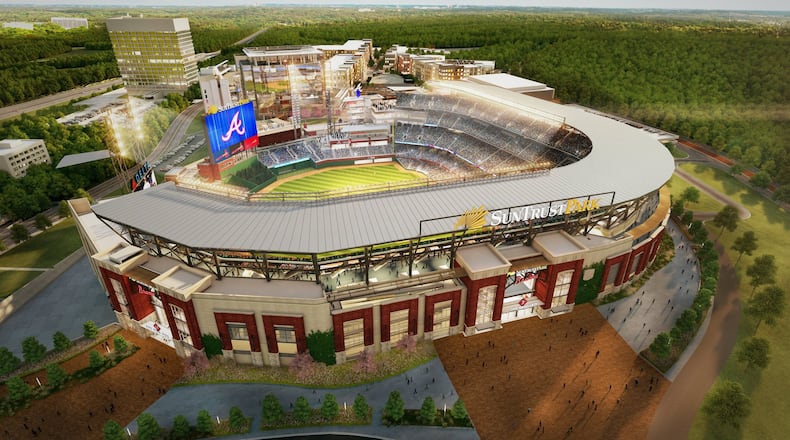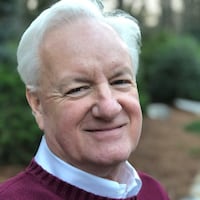Yes, the Braves considered putting a retractable roof on their new stadium.
“I think it was a relatively brief conversation,” Derek Schiller, the team’s president of business, recalled.
After rejecting a roof for reasons of cost and baseball tradition, the Braves asked the architects of SunTrust Park for a design that “would have as many of our seats covered as possible, outside of having a roof,” Schiller said.
One result of that directive is easily noticed at the stadium construction site in Cobb County these days: The steel framework for a wide canopy hangs above the upper deck, protruding as much as 60 feet over what eventually will be rows of seats.
Whether protection from sun and rain will make many fans want to sit near the top of the ballpark remains to be seen. But the 108,000-square-foot canopy will provide the option, as well as an architectural element.
“It definitely is first and foremost a functional characteristic, but it’s been designed in such a way that it creates part of the look and feel,” Schiller said. “It is a signature design element.”
The canopy, supported by about 25 structural steel columns, will be different widths at different places — wider toward left field than toward right field. The top side of the canopy framework will be covered with metal, which appears light gray in some renderings, but according to Schiller, will be off-white. On the under-side, LED light strips will glow and provide the ability to change colors.
“When we win a game, perhaps the canopy turns a certain color,” Schiller said.
(Of course, for that feature to get much use, the Braves will have to improve on the field. The team has just nine wins in 36 home games this season, their last at Turner Field before next year’s move to SunTrust Park.)
A visitor to the new stadium this past week, SunTrust Banks corporate executive vice president Jenner Wood, a baseball fan who has been to 18 MLB stadiums, said the canopy reminds him a bit of the one at Dodger Stadium in Los Angeles.
“I think the canopy is more far-reaching here,” Wood said. “It’s going to provide a great sun cover and rain protection for a lot of people.”
Earl Santee, a founder and senior principal of Kansas City-based architecture firm Populous, which designed 19 of the 30 current MLB stadiums, said the Braves’ stadium will have “the largest canopy we’ve done or seen in major-league baseball.”
It isn’t nearly as extensive, though, as the massive canopy currently being installed atop the stadium of the NFL’s Miami Dolphins. The Dolphins say that one will shade 92 percent of the fans.
The Braves’ canopy will be 80 feet wide at its widest point, with 20 feet of that covering the upper-level concourse and the remainder extending over rows of seats.
Santee, a lead designer of 41,500-seat SunTrust Park, estimated during a tour of the stadium last month that the canopy and the cantilevered seating sections throughout the stadium will combine to shade as many as 60 percent of the fans at afternoon games. The Braves typically play 18 to 20 home afternoon games per season, mostly on Sundays.
SunTrust Park’s cantilevering, another key element of the design, will push portions of the upper and middle decks closer to the field by overhanging the seats below them.
Santee said the 60-percent shade figure was based on computer analysis “and is actually a great number.”
(But from looking around the southeast-facing ballpark-in-progress on a sunny day last week, the computer’s figure might be high.)
“The ultimate width of the canopy was largely a function of the engineering parameters,” Schiller said. “An analysis was done to determine the maximum width we could do, but also have something that fit in with the look (of the stadium).”
Some early SunTrust Park season-ticket buyers have sought out seats with protection from the elements, Schiller said, although he added that the bigger drivers of seat selection remain “things such as ‘I want to be on the first-base side,’ ‘I want to be on the third-base side,’ ‘I want to be near the Braves dugout,’ ‘I want to be behind home plate’, ‘I want to be first-row upper level.’”
What Braves executives didn’t want, they decided early in their ballpark brainstorming, was a retractable roof.
“Early on, we discussed a facility that might include a roof, but there are a variety of reasons we didn’t go down that path,” Schiller said. “Some of it is cost. It is cost-prohibitive. But at the end of the day, the real reason is we believe baseball is an outdoor sport.
“I think our fans would prefer to be outside in the elements, albeit with as many of the amenities and protections and things like the canopy that we can make part of the design. … We all felt watching Braves baseball was better outdoors than indoors.”
SunTrust Park will cost $672 million, and by some estimates a retractable roof could have added $150 million, plus increased annual operating costs.
The Falcons’ new downtown stadium, also slated to open next year, will have a retractable roof, which team officials have said they intend to keep open for as many games as practicable. That roof was a necessity because Mercedes-Benz Stadium will be used for many indoor events, including college basketball’s Final Four in 2020.
About the Author




